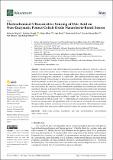| dc.contributor.author | Masrat, Sakeena | |
| dc.contributor.author | Nagal, Vandana | |
| dc.contributor.author | Khan, Marya | |
| dc.contributor.author | Moid, Iqra | |
| dc.contributor.author | Alam, Shamshad | |
| dc.contributor.author | Bhat, Kiesar Sideeq | |
| dc.contributor.author | Khosla, Ajit | |
| dc.contributor.author | Ahmad, Rafiq | |
| dc.date.accessioned | 2022-12-12T13:30:56Z | |
| dc.date.available | 2022-12-12T13:30:56Z | |
| dc.date.issued | 2022-12-07 | |
| dc.identifier.uri | https://hdl.handle.net/1721.1/146832 | |
| dc.description.abstract | Transition metal oxide (TMO)-based nanomaterials are effectively utilized to fabricate clinically useful ultra-sensitive sensors. Different nanostructured nanomaterials of TMO have attracted a lot of interest from researchers for diverse applications. Herein, we utilized a hydrothermal method to develop porous nanosheets of cobalt oxide. This synthesis method is simple and low temperature-based. The morphology of the porous nanosheets like cobalt oxide was investigated in detail using FESEM and TEM. The morphological investigation confirmed the successful formation of the porous nanosheet-like nanostructure. The crystal characteristic of porous cobalt oxide nanosheets was evaluated by XRD analysis, which confirmed the crystallinity of as-synthesized cobalt oxide nanosheets. The uric acid sensor fabrication involves the fixing of porous cobalt oxide nanosheets onto the GCE (glassy carbon electrode). The non-enzymatic electrochemical sensing was measured using CV and DPV analysis. The application of DPV technique during electrochemical testing for uric acid resulted in ultra-high sensitivity (3566.5 µAmM<sup>−1</sup>cm<sup>−2</sup>), which is ~7.58 times better than CV-based sensitivity (470.4 µAmM<sup>−1</sup>cm<sup>−2</sup>). Additionally, uric acid sensors were tested for their selectivity and storage ability. The applicability of the uric acid sensors was tested in the serum sample through standard addition and recovery of known uric acid concentration. This ultrasensitive nature of porous cobalt oxide nanosheets could be utilized to realize the sensing of other biomolecules. | en_US |
| dc.publisher | Multidisciplinary Digital Publishing Institute | en_US |
| dc.relation.isversionof | http://dx.doi.org/10.3390/bios12121140 | en_US |
| dc.rights | Creative Commons Attribution | en_US |
| dc.rights.uri | https://creativecommons.org/licenses/by/4.0/ | en_US |
| dc.source | Multidisciplinary Digital Publishing Institute | en_US |
| dc.title | Electrochemical Ultrasensitive Sensing of Uric Acid on Non-Enzymatic Porous Cobalt Oxide Nanosheets-Based Sensor | en_US |
| dc.type | Article | en_US |
| dc.identifier.citation | Biosensors 12 (12): 1140 (2022) | en_US |
| dc.contributor.department | Singapore-MIT Alliance in Research and Technology (SMART) | |
| dc.identifier.mitlicense | PUBLISHER_CC | |
| dc.eprint.version | Final published version | en_US |
| dc.type.uri | http://purl.org/eprint/type/JournalArticle | en_US |
| eprint.status | http://purl.org/eprint/status/PeerReviewed | en_US |
| dc.date.updated | 2022-12-09T20:23:25Z | |
| dspace.date.submission | 2022-12-09T20:23:24Z | |
| mit.license | PUBLISHER_CC | |
| mit.metadata.status | Authority Work and Publication Information Needed | en_US |
